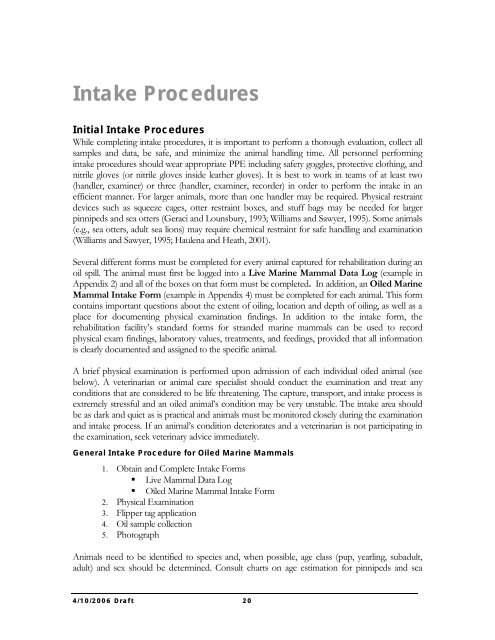Volume III, Appendices EM - National Marine Fisheries Service ...
Volume III, Appendices EM - National Marine Fisheries Service ...
Volume III, Appendices EM - National Marine Fisheries Service ...
You also want an ePaper? Increase the reach of your titles
YUMPU automatically turns print PDFs into web optimized ePapers that Google loves.
Intake Procedures<br />
Initial Intake Procedures<br />
While completing intake procedures, it is important to perform a thorough evaluation, collect all<br />
samples and data, be safe, and minimize the animal handling time. All personnel performing<br />
intake procedures should wear appropriate PPE including safety goggles, protective clothing, and<br />
nitrile gloves (or nitrile gloves inside leather gloves). It is best to work in teams of at least two<br />
(handler, examiner) or three (handler, examiner, recorder) in order to perform the intake in an<br />
efficient manner. For larger animals, more than one handler may be required. Physical restraint<br />
devices such as squeeze cages, otter restraint boxes, and stuff bags may be needed for larger<br />
pinnipeds and sea otters (Geraci and Lounsbury, 1993; Williams and Sawyer, 1995). Some animals<br />
(e.g., sea otters, adult sea lions) may require chemical restraint for safe handling and examination<br />
(Williams and Sawyer, 1995; Haulena and Heath, 2001).<br />
Several different forms must be completed for every animal captured for rehabilitation during an<br />
oil spill. The animal must first be logged into a Live <strong>Marine</strong> Mammal Data Log (example in<br />
Appendix 2) and all of the boxes on that form must be completed. In addition, an Oiled <strong>Marine</strong><br />
Mammal Intake Form (example in Appendix 4) must be completed for each animal. This form<br />
contains important questions about the extent of oiling, location and depth of oiling, as well as a<br />
place for documenting physical examination findings. In addition to the intake form, the<br />
rehabilitation facility’s standard forms for stranded marine mammals can be used to record<br />
physical exam findings, laboratory values, treatments, and feedings, provided that all information<br />
is clearly documented and assigned to the specific animal.<br />
A brief physical examination is performed upon admission of each individual oiled animal (see<br />
below). A veterinarian or animal care specialist should conduct the examination and treat any<br />
conditions that are considered to be life threatening. The capture, transport, and intake process is<br />
extremely stressful and an oiled animal’s condition may be very unstable. The intake area should<br />
be as dark and quiet as is practical and animals must be monitored closely during the examination<br />
and intake process. If an animal’s condition deteriorates and a veterinarian is not participating in<br />
the examination, seek veterinary advice immediately.<br />
General Intake Procedure for Oiled <strong>Marine</strong> Mammals<br />
1. Obtain and Complete Intake Forms<br />
Live Mammal Data Log<br />
Oiled <strong>Marine</strong> Mammal Intake Form<br />
2. Physical Examination<br />
3. Flipper tag application<br />
4. Oil sample collection<br />
5. Photograph<br />
Animals need to be identified to species and, when possible, age class (pup, yearling, subadult,<br />
adult) and sex should be determined. Consult charts on age estimation for pinnipeds and sea<br />
4/10/2006 Draf t 20
















